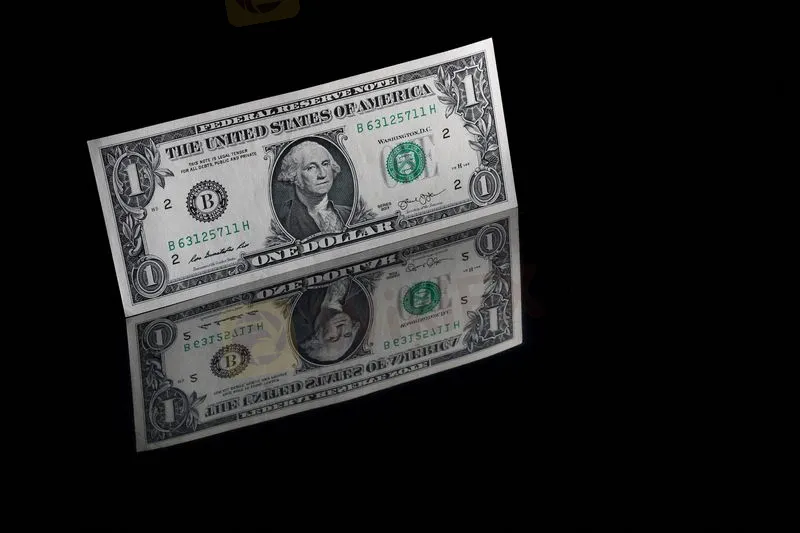简体中文
繁體中文
English
Pусский
日本語
ภาษาไทย
Tiếng Việt
Bahasa Indonesia
Español
हिन्दी
Filippiiniläinen
Français
Deutsch
Português
Türkçe
한국어
العربية
Dollar suffers biggest drop in six weeks after U.S. jobs report
Abstract:The dollar was on track for its biggest daily percentage drop in six weeks on Friday on the heels of the December U.S. jobs report that missed expectations, but it was still seen as strong enough to keep the Federal Reserve's tightening path intact.

The dollar was on track for its biggest daily percentage drop in six weeks on Friday on the heels of the December U.S. jobs report that missed expectations, but it was still seen as strong enough to keep the Federal Reserve's tightening path intact.
The dollar index fell 0.546% at 95.734, and was poised for its biggest drop since Nov. 26, when concerns about the Omicron COVID-19 variant began to rattle markets. Even with Friday's weakness, the dollar was still on track for a slight weekly gain, its first in three weeks.
The Labor Department said nonfarm payrolls rose by 199,000 last month, well short of the 400,000 estimate. But analysts noted underlying data in the report appeared sturdier, with the unemployment rate falling to 3.9% against expectations of 4.1% while earnings rose by 0.6%, indicating tightness in the labor market.
The report also increased expectations the Fed will begin to hike interest rates at its March meeting, with futures on the federal funds rate implying a 90% chance of a hike, up from 80% on Wednesday.
“While the headline might have fallen short of the consensus, the consensus doesn't matter much to the Fed. For them, this probably justifies their hawkish tilt,” said Brian Jacobsen, senior investment strategist at Allspring Global Investments in Menomonee Falls, Wisconsin.
“We'll have to see how whether they walk the walk of their hawkish talk, but the odds are rising for a rate hike in March or May and a balance sheet run-off beginning later next year.”
On Wall Street the benchmark S&P 500SPX> was modestly lower, while the yield on the benchmark 10-year U.S. Treasury note touched 1.80%, its highest since January 2020.
The euro was up 0.62% to $1.1361 as it strengthened against the greenback in the wake of the payrolls report, after showing little reaction to data showing euro zone inflation rose to 5% in December.
Euro zone policymakers have said they expect inflation to gradually slow down in 2022 and a rate hike will likely not be needed this year.
The Japanese yen strengthened 0.22% versus the greenback at 115.59 per dollar. The yen has taken the brunt of the damage while the greenback has strengthened recently, with the dollar hitting a five-year high versus the yen earlier this week.
Sterling was poised for its third straight weekly gain against the dollar and was last trading at $1.3592, up 0.47% on the day, even after data showed growth in Britain's construction sector cooled in December as the Omicron variant of coronavirus spread, nearly matching a two-month high reached on Wednesday.
Despite the rapid spread of the Omicron variant, investors have increasingly viewed it as unlikely to derail the global economy or more aggressive actions by central banks.
In cryptocurrencies, Bitcoin last fell 2.96% to $41,822.60 after hitting a low of $40,600, its lowest since Sept. 22. Ethereum last fell 6.27% to $3,194.51, on track for a third straight daily decline, after touching its lowest level since Oct 1.
Disclaimer:
The views in this article only represent the author's personal views, and do not constitute investment advice on this platform. This platform does not guarantee the accuracy, completeness and timeliness of the information in the article, and will not be liable for any loss caused by the use of or reliance on the information in the article.
Read more

Germany's Election: Immigration, Economy & Political Tensions Take Centre Stage
Germany is set to hold a crucial general election on 23 February 2025, with voter frustration over migration emerging as a dominant issue.

ED Exposed US Warned Crypto Scam ”Bit Connect”
The Indian Enforcement Directorate (ED) recently exposed a crypto Scam from a firm called Bitconnect. During the investigation, which took place on February 11th and 15th, 2025. The authority recovered bitcoin worth approximately Rs 1,646 crore & Rs 13.50 Lakh in cash, a Lexus car, and digital devices. This investigation was conducted under the provisions of the Prevention of Money Laundering Act (PMLA) of 2002.

Why Do You Keep Blowing Accounts or Making Losses?
For many traders, consistent losses can feel like an inevitable part of the journey. Some blame the market, others point fingers at brokers, and many convince themselves that luck simply isn’t on their side. But the reality is that repeated trading losses are rarely down to bad luck alone. Instead, a mix of psychological, emotional, and technical factors often leads traders down the path of blown accounts and frustrating setbacks. Understanding these deeper issues is key to breaking the cycle and becoming a more resilient and strategic trader.

Trade War May Escalate, Gold Panic on the Rise
Trump comments on the Russia-Ukraine war, gold rises again to reach a new all-time high.
WikiFX Broker
Latest News
Germany's Election: Immigration, Economy & Political Tensions Take Centre Stage
WikiFX Review: Is IVY Markets Reliable?
IG 2025 Most Comprehensive Review
ED Exposed US Warned Crypto Scam ”Bit Connect”
Top Profitable Forex Trading Strategies for New Traders
EXNESS 2025 Most Comprehensive Review
Currency Calculator






